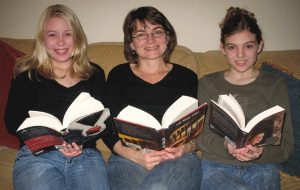Last night Catherine and I hosted our book club (9th grade girls) to talk about The Egg and I by Betty MacDonald. A classic book first published in 1947, The Egg and I tells the story of life for Betty and her husband when they buy a chicken farm in a remote area of Washington State’s Olympic Peninsula.
While there were obviously some challenges in reading the book (different writing style, a few outdated references to things neither of us knew about) all in all it was fun to read and talk about. Many of the passages actually made us laugh out loud. Betty’s wit in looking at a life and a community filled with never-ending work and many hardships is a treasure for the glimpse it gives us into rural life just before the Depression.
While it would have been easy for us to talk about some of the funniest passages, we chose instead to focus our discussion on two issues: the role of women in those days versus today, and the part racism plays in how we view others who are not like us. There was a lot to talk about with both topics.
The Egg and I starts with Betty saying that her mother taught her at an early age to always be sure she did everything she could to help her husband be happy with his work. That advice is what probably contributed greatly to Betty’s ending up on the chicken farm, a place she may not have ever chosen for herself if her husband had not wanted to go into the business. Once there she throws herself into making the experience as successful as possible, while combating loneliness, fatigue and isolation. The girls all felt their experience would involve more compromise than Betty had, and they’d be able to work toward what they want to do in life as well as what their eventual husbands may want to do.
The moms tended to think we’re still in transition. While relations between the sexes have come a long way since the 1920s, the reality today is that far more women move for their husbands’ careers than the other way around. But the trend shows a positive gradual change.
As for racism, we talked about how easy it often is for people to look at someone, not like what they see, and assign the characteristics they don’t like to everyone who is of the same race. If instead we see people as people, we see that people of all races often struggle with the same problems, and we’re more likely to think of those as individual instead of racial issues.
I expect next month we’ll be bringing some of those same points up again and discussing them even more when we talk about The Secret Life of Bees by Sue Monk Kidd, our next book.



Excuse me — you had to get out the racism card and play it on Betty MacDonald? Did it ever occur to you that she may have been reporting exactly what she saw when she wrote about the Indians — with the same insight, wit, and occasional forbearance that she showed for the Kettles and the Hicks?
How racist of you to assume that you “know better.”
Sorry you interpreted those comments to mean I “know better,” Brenda. As I originally wrote, it’s racist to look at the actions of a few people and determine that everyone in their race must be the same way. I stand by my words, “If instead we see people as people, we see that people of all races often struggle with the same problems, and we’re more likely to think of those as individual instead of racial issues.”
Hi Cindy – I just recently read this book and I agree with your comments on women’s role (then versus now) and the racist comments towards Native Americans in the book. While Betty points out, usually with humor, the good and the bad in each individual character, she does get out the big, broad brush when she makes disparaging remarks towards Native Americans. While I disagree with such remarks, I am glad that modern publishers have left them in so we can see how far society as a whole has progressed.
Hi Susan –
Thanks for your comment and your thoughts on this book. I, too, am glad modern publishers don’t edit out things that may not reflect current thought. I believe it’s important to know what life was like in days past. Seeing the progression provokes thought and discussion about the way things used to be compared to how they are and how they are moving for the future.